Nigeria’s Culture and Heritage


The Nigerian government in September 1988, launched the “National Cultural Policy”. This policy document defined culture as “the totality of the way of life evolved by a people in their attempt to meet the challenges in their environment which gives order and meaning to their social, political, economic, aesthetic and religious norms and modes of organization, thus distinguishing a people from their neighbour”.
As a further step, the Federal Government in June 1999, created the Federal Ministry of Culture and Tourism by mid-2006, the ministry was renamed Federal Ministry of Tourism, Culture and National Orientation, with the mandate to promote the nation’s rich cultural heritage, through the identification, development and marketing, of the diverse cultural and tourism potentials.
However, in November 2015, the Ministry of Culture and Tourism was later merged with the Ministry of Information, which is now known as the Ministry of Information, Culture and Tourism.
The culture of Nigeria is shaped by Nigeria’s multiple ethnic groups. The country has over 50 languages and over 250 dialects and ethnic groups. The three largest ethnic groups are the Hausa-Fulani who are predominant in the north, the Igbo who are predominant in the southeast, and the Yoruba who are predominant in the southwest. The Edo people are predominant in the region between Yoruba land and Igbo land. Much of the Edo tend to be Christian while the remaining 25 percent worshipped deities called Ogu. This group is followed by the Ibibio/Annang/Efik people of coastal southeastern Nigeria and the Ijaw of the Niger Delta.
The rest of Nigeria’s ethnic groups (sometimes called ‘minorities’) are found all over the country but especially in the middle belt and north. The Hausa tend to be Muslim and the Igbo are predominantly Christian. The Efik, Ibibio, and Annang people are mainly Christian. The Yoruba have a balance of members that are adherent to both Islam and Christianity. Indigenous are often blended with Christian beliefs.
Cultural Diversity and Common Ties
It is popularly believed that Nigeria has about three hundred fifty linguistic groups Language is the vehicle for creating and mastering the complex realities that define any geographical expression. It is the most dynamic element of any culture or society. Languages are vital for transmitting knowledge, world views and verbal arts over the years. These languages and the cultures they transmit are however not barriers but bridges of understanding and mutual cooperation across their respective frontiers which differentiates them as entities sometimes referred to as “ethnic nationalities”. Some superstructures are known to have grown which helps to mediate the diversities and channel them into harmonies and unity. This is why today we talk about “Unity in Diversity”. Examples of such include dress modes, inter-ethnic marriages, shared religious beliefs and practices as well as commerce. People have equally developed an interest in other cultures to the extent of speaking different languages and taking names from other cultures for their children.
In the area of dressing, Nigeria is characterized by the diversity of its traditional attire. It is fashionable for Nigerians to wear the traditional dresses of their regions or ethnic groups of origin. The Igbo men from the southeast geo-political region for instance are known for their red caps just as the hat is a peculiar feature of men’s traditional wear in the Niger Delta region. In Benue State, the “Ange” cloth characterized by its zebra-like black and white stripes is used by the Tiv people while their Idoma neighbours wear similar clothes with red and black stripes. But it is not uncommon for Nigerians to adopt particular attires from other regions which have become very popular. The ensemble “Baban Riga” (or “Agbada”), “Buba” and “Shokoto”, complete with a cap to match, or the “Kaftan” which are popular among the men-folk in the north (predominantly Hausa/Fulani) are now worn by people from other parts of the country. In western Nigeria, the Yoruba brand of the “Agbada”, “Buba”, and “Shokoto”, with the cap to match, has become popular too.
The recently introduced attire, referred to as “resource control”, which was initially associated with men from the Niger Delta region has today become a common outfit across the length and breadth of Nigeria. As for the women- folk, the “Buba”, “Iro”, “Gele”, and “Ipele” have been adopted across the regions with minor nuances of style. Although attached to the uniqueness of the traditional attires of their places of origin, Nigerians are also simple lovers of beauty and so do not hesitate to adopt a fashion or an object of beauty that appeals to them. Most of these cloths are products of hand-woven fabrics such as “Akwete”, “Aso-Oke”, “Batik”, “Tie and Dye”, “Otaochi”. These materials are the vogue in the textile industry. Nigerians have carved a niche for themselves in the fashion world. The use of “Ankara” materials by both men and women sets Nigerians apart in fashion at home and internationally.
Literary and Performing Arts




Writers and performing artistes, the world over are regarded as the “cultural engineers” of society. This is because they help to create and lubricate the fabrics of societal stands and joints through their creativity. Literary arts in Nigeria has enjoyed greater patronage since its Independence in 1960. With the increasing documentation of folklore and traditions, the literary arts has witnessed phenomenal growth. This has equally given prominence to Nigerian authors and scholars within and outside the country.
These literary icons include Wole Soyinka, the first Black writer to win the Noble Prize of Literature in 1986, late Chinua Achebe, Cyprian Ekwensi, John Pepper Clark, Gabriel Okara, Abubakar Imam, Flora Nwapa, Zulu Sofola, Amos Tutuola, Chukwemeka Ike, Elechi Amadi, Chimamanda Adichie to mention these few. This development has encouraged script writers to have a reservoir of materials for film scripts used especially by Nollywood film producers.
Nigerian Cuisine and Gastronomy
The Nigerian culinary practice is as diverse as the country’s ethnic groups. Every ethnic group is associated with particular cuisine which they hold as dear to them. The major traditional dishes and delicacies which have become national heritage include Edikaikon, Okoho, Fufu, Tuwo, Akpu, Suya, Kilishi, Gbegeri, Owo, Bush meat, Fura de nunu, Kunu, Amala, Eba, Pounded yam.
Today, Nigerians from various cultures prefer these foods to Western or so-called continental dishes. The popular snacks include Akara, Boli and Corn (boiled, popped or roasted). The beauty in the Nigerian experience is that guests are fed generously.
Nigerian Arts and Crafts in building decoration and landscaping
It is not particularly an easy exercise to draw a straight line of demarcation between arts and crafts. This is usually so because the same artist (genius) who produced the beautiful bronze head, could be involved in the production of ornaments of brass, just as the same carver who produced a door panel could be involved in making stool, comb or ritual drum. It is however accepted that the first product by the same artist from a mould represents art, while subsequent products from that same mould are classified as craft, though coming from the same artist.
Each product is intended for a specific usage. Generally, climate, geography and religious factors play vital roles in art or craft production as the main motive or idea was utility and aesthetic satisfaction. These factors are equally responsible for the decoration of such objects of everyday use, for example, granary, door panels, bowls, knife handles, drinking horns, special design of the rulers’ roofs and walls (interior and exterior), etc.
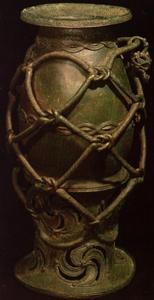
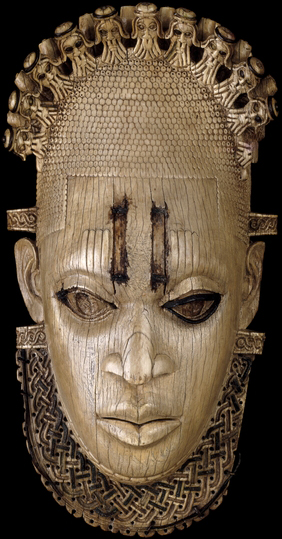

Nigerian craftsmen have been in their trade for over two thousand years. Their efforts are known to have produced the terra-cotta and iron smelting tradition of Nok, Ife, Igbo-ukwu and Benin bronze respectively. These high-quality works of art represent evidence of early civilization in Nigeria. The works of art enjoy patronage, especially from the royal palaces and homes of wealthy personalities in Nigerian society. Such patronage encouraged the production of state swords, sceptres, royal drums, ivory ornaments, whisks fans beaded handles, crowns and various royal regalia. A few examples may suffice.
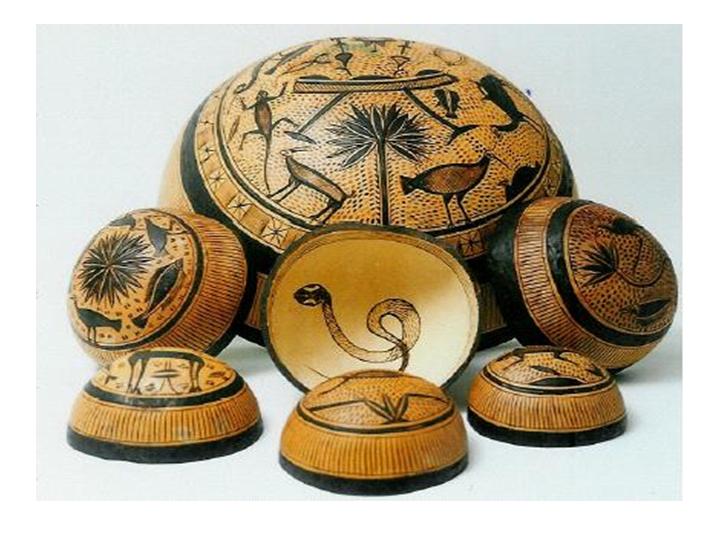
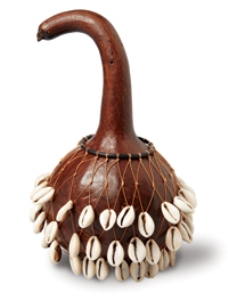
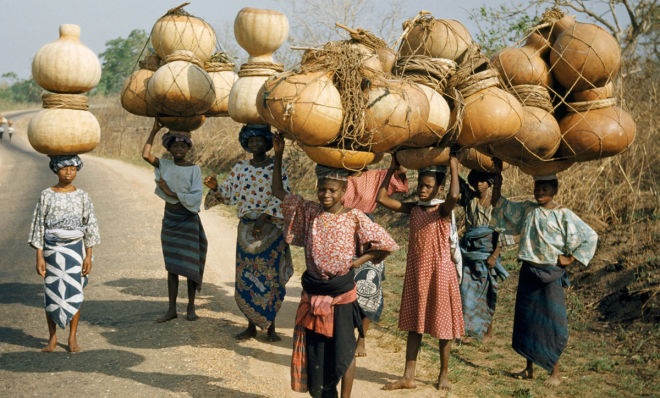
Calabash carving is a prominent craft practice with a long-standing tradition in Nigeria. For instance, Old Oyo is well associated with this practice as well as some communities in Plateau, Bauchi, Sokoto, Adamawa and Bornu states. They produced burnt or engraved geometric designs on calabashes which are widely used and marketed across the country. These crafts now enjoy patronage in many African countries. This craft item is sometimes used as a wall hanging, and so also are raffia-based crafts.
In the area of buildings decorated with arts and crafts, Nigeria has a long tradition of such practice. This is where door panels and wooden and stone objects are utilised as “Installation Art” pieces. It is a common feature these days to see beautiful art displays and expressions on edifices across the country. Most of these designs utilise marble materials such as “Mosaïc”. There are also giant artworks in front of edifices, developed from wood, bronze, Iron and Fibre. An example of this artistic expression is the giant artwork at the defunct NEPA building in Lagos.
In Nigeria, landscaping appears to be incomplete without works of art. This is why most roundabouts across the country are adorned with giant art pieces. Some of these works tell the tourist about the dominant cultural activities of the people of the region. For example, a tourist entering Makurdi the Capital of Benue State is presented with an art expression that this is the “Food Basket of the Nation”. These decorations depict Nigerians as lovers of beautiful environments and as people endowed with creativity.
Contemporary Painting and Sculpture
The creative inspirations of early civilizations such as the Nok, Ife, Benin and Igbo-Ukwu presented the foundation and platform for the creative evolution of cycles and generations of modern artists in Nigeria. Art traditions which started with traditional carvers have today metamorphosed into contemporary art with “western-trained” artists. Nigeria has since Independence produced five generations of modern artists. What started with people like Aina Onabolu has produced young artists like Samuel Onyilo, Paul Oluwole, etc. These artists were trained in Art Schools in Nigeria.
In the area of painting, their works cover a wide range of colours and expressions. These expressions or art forms use watercolours and acrylics to produce a wide range of techniques. Some undertake a technique known as wood burning or mixed media. Nigerian sculptors are very outstanding in their art forms and expressions. They produce works on wood, Iron, Bronze and Stones among other features. Their works are found in major galleries and private homes globally, and some of their commissioned works adorn major round-about in most cities across the country. The patronage covers private individuals, companies and government agencies.
CULTURAL AND HISTORICAL ATTRACTIONS
HISTORICAL OBAS’ AND EMIRS’ PALACES
Alafin of Oyo’s Palace
It is a historical and cultural monument described as a Yoruba museum containing relics and antiquities of the Yoruba race. The Aganju hall, the 150-year-old tortoise and an expansive courtyard are some of the prominent features.
Oba of Lagos’ Palace (Iga Idungaran)
This is a cultural centre and the palace of the Oba of Lagos. The palace was believed to have been built in 1670.
Emir of Kano’s Palace (Kano City)
It is a magnificent architectural design. The palace is a settlement within a settlement. Built in the 15th century by the 20th Empire of Kano, it is now like a museum.
Oba of Benin’s Palace
Is a unique traditional architecture and works of arts dating back to the 9th and 10th centuries located near the Kings Square in Benin City.
Emir of Zaria’s Palace (Zaria)
This is a magnificent edifice and historical monument built some 200 years ago. The palace is built in a traditional Hausa architectural design and has endured the trials of modernity and time.
Ooni of Ife’s Palace (Ile-Ife)
It is among the historic monuments of the state, being the ancestral home and spiritual headquarters, of the Yoruba race.
NATIONAL MUSEUMS
National Museum, Oron, Akwa Ibom State
It was established in 1959. The museum is reputed as containing the largest ethnographic gallery in Africa, a craft shop and an African cuisine restaurant.
National Museum Benin City
It has a rare collection of antiquities and artefacts of the rich cultural past of the state. The Benin Museum represents the ancient and modern artistic ingenuity of the Edo people and some major cultures of Nigeria.
National Museum Kaduna
It is rich with collection of diverse antiquities, artefacts and relics of Nigerian cultural heritage. This is the home of the over 2500 years old Nok Terracotta collections. There are also many other sculptural, craft and art collections in the museum.
National Museum and Monument Lagos
It contains some of the country’s rare collections of works of arts and crafts and historic monuments. It is a good place to visit for further discovery about the hardworking people of Lagos and Nigeria.
Museum of Traditional Nigerian Architecture (MOTNA)
It is located in the Jos metropolis. It is a museum depicting the diverse traditional Nigerian architecture.
Ife Museum Ile-Ife
It dates back to 1930, and houses various objects of antiquity which abound in Ile-Ife from time immemorial. Among important collections in the museum is the granite tools, crubicles fused for making beads, brass of Ooni of Ife, and terracotta artworks, etc.
HOTELS AND RESTAURANTS
There are several hotels located in different parts of the country. These range from First Class, Second Class and Third Class according to international standards and specifications. Hotels activities are regulated by the Nigerian Tourism Development Corporation (NTDC).
Hotels provide job opportunities for citizens as well as foreigners as they employ both skilled and unskilled workers. Hotels serve as avenues for generating income through support for the entertainment industry in the country. For instance, they provide opportunities for music and Nollywood stars to do stage performances. Some notable hotels in the country include Transcorp Hotel, Abuja; Sheraton, Lagos; Continental Hotel, Lagos; Hotel Presidential, Enugu; Premier Hotel, Ibadan and Hamdala Hotel, Kaduna, Eko Hotel, Lagos.


